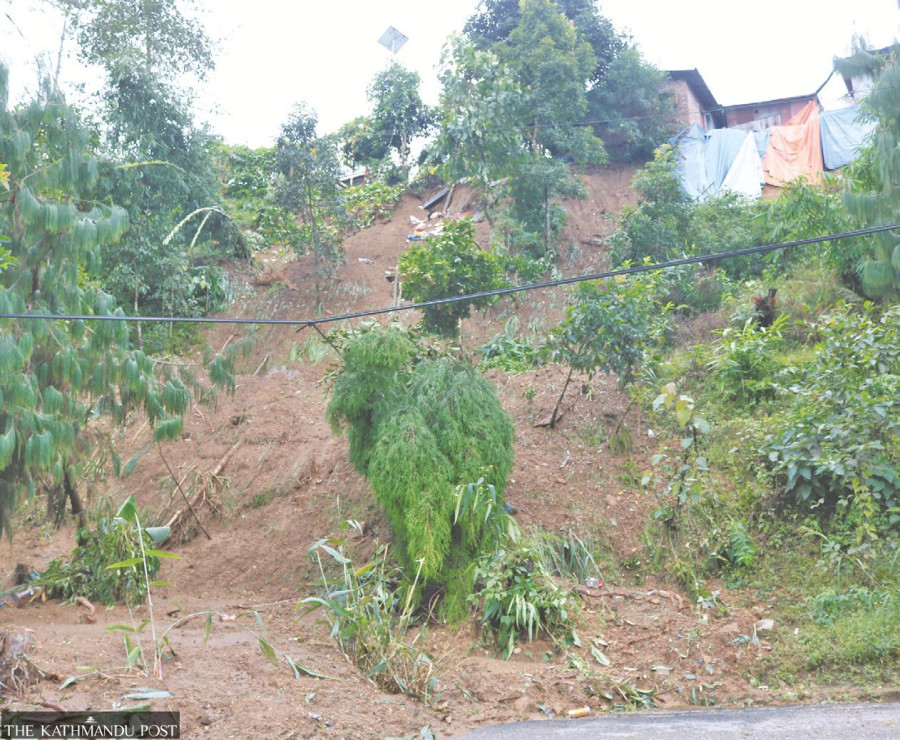National
Lack of disaster management and preparedness raises alarm
Local governments’ complacency in implementing disaster risk management and post-disaster plans might lead to a repeat of last year’s tragedy, locals say.
Biplav Bhattarai
On October 18 and 19 last year, landslides triggered by unseasonal rainfall killed 15 people in five local units in Ilam. Two went missing in the incident.
A few days prior to the landslide, transportation along the Narayansthan road section of the Mechi Highway, considered the lifeline of eastern Ilam, was disrupted for a month because of multiple landslides along the road section.
The road blockage left several landslide victims stranded with no access to transportation to move to safer areas. Several weeks later, one side of the road was opened for vehicle movement. It took a month for the entire road section to open since the local unit and the road division could not agree on whose responsibility it was to clear and mend the road section, according to Bidhru Pokhrel, chief of the Road Division Office in Ilam.
Most of the rural road sections in the district including the Mechi highway were damaged by soil erosion and landslides in October last year.
The district’s residents fear that they may have to face similar disasters this year also and complain that the local unit has not prepared for possible disasters this year either.
Kishor Kripalu, a resident of Ilam Municipality -7, says people lost their lives and property to last year’s October landslide because the local unit was unprepared for disasters.
“But this year too, the local authorities have not made any preparations even though the monsoon is upon us,” said Kripalu. “No major incidents have occurred so far but considering the previous year, monsoon season is not the only time we are at risk of natural disasters.”
There are increasing complaints from several quarters that the local unit has not done the necessary work for disaster risk reduction and management.
According to the district administration office, 10 municipalities of Ilam are at risk of landslides and mudslides.
Madhav Dhungana, Ilam’s chief district officer, said his office is currently collecting data on people living in high-risk areas. A district disaster preparedness and response plan have also been sent to the local units, he said.
Dhungana said that while the district formulates disaster management plans, it is the local units’ responsibility to implement them.
The district administration estimates 1,973 members of 550 families are currently at risk of landslides while 1,200 households are at risk of mudslides.
“The local units have not learned anything from their previous mistakes,” Dhungana said. “The elected representatives of the local units say they will complete the disaster prevention and preparation work in a month but disasters don’t adhere to time frames. Anything can happen anytime.”
According to Dhungana, the local units’ infrastructure development projects have caused harm to the topography. “They allow construction activities without doing environmental impact studies,” he said. “The local units have yet to realise how they are putting everyone at risk with their haphazard construction projects.”
A couple of weeks ago, a landslide damaged three houses in the Chisapani market of Mansegung Rural Municipality. There were no casualties.
Ran Bahadur Rai, mayor of the Suryadev Municipality, said the local unit has not started disaster prevention and management works yet and that they plan to complete all preparations within a month.
Superintendent of Police Mahendra Shrestha said they have informed all 81 wards of the district to purchase the essential rescue materials needed in case of disasters. “The Local Government Operation Act 2074 has given all the needed power and authority to the municipalities in disaster mitigation, management and relief,” Shrestha said. “There is nothing stopping them from preparing for the worst.”
Every district has a disaster risk reduction and management committee at the district level under the chairmanship of the chief district officer and one at the local unit headed by the chairman of the ward that is at most risk of disasters.
According to the District Administration Office, the risk of landslides is high in the highlands and central areas of the district. Development activities—roads, irrigation and infrastructure—in the Chure region have increased over the years exposing the Chure region to natural disasters.
Dhungana, the chief district officer, said that unless local units make a detailed plan based on the local situation, formulating action plans at the district level will not be sufficient to prevent disasters and arrange for post-disaster help for the victims.




 13.12°C Kathmandu
13.12°C Kathmandu















